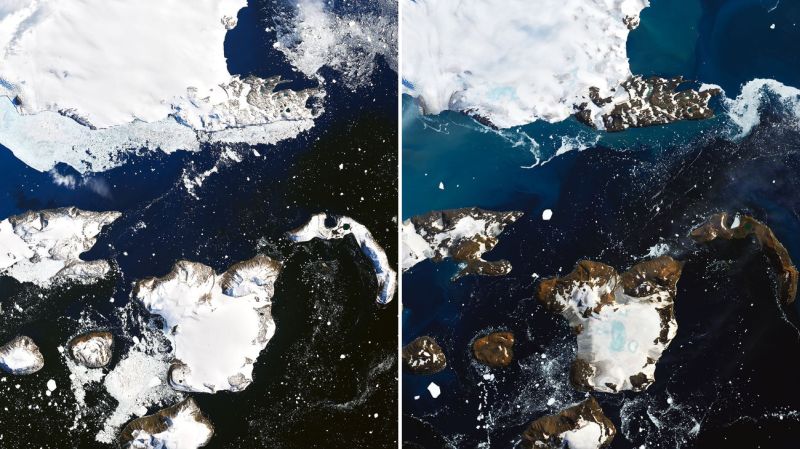NASA Reveals Shocking Before and After Images of Melting Antarctica
The 21st century has so far revealed the tangibility of threats of global warming and climate change. Extreme weathers, unending spells of droughts, floods, and escalating water scarcity are the very evidence of these threats. Another addition to this list is rapidly melting glaciers. Recently, NASA revealed shocking before-and-after images of melting Antarctica.
Satellite images of the northern Antarctic Peninsula from NASA show the effects of the recent record high temperatures on the continent. Once covered with ice, there were now brown patches of land, the melted snow and ice have created water ponds.

NASA revealed shocking before-and-after images of melting Antarctica / Image: NASA
The images center on Eagle Island, part of the northern tip of the Antarctic Peninsula that spans toward South America. The first image was taken on February 4, while the other was taken nine days later on February 13.
Dramatic changes took place in such a short time span. According to NASA, two days after the first photo was taken, the temperature of the area hit 18.3 degrees Celsius, matching the temperature in Los Angeles on the same day.
The space agency noted,
The warm spell caused widespread melting on nearby glaciers. Such persistent warmth was not typical in Antarctica until the 21st century, but it has become more common in recent years.
On February 6, the Eagle Island witnessed the biggest loss of ice and snow, when an inch of snow melted. By February 11, the island had lost 4 inches of snow.
Mauri Pelto, a glaciologist at Nicolas College in Massachusetts, said in NASA’s news release about the phenomenon that she hasn’t seen melt ponds develop this quickly in Antarctica.
Experts at the World Meteorological Organization are still verifying the record. According to the agency, the Antarctic Peninsula is one of the fastest-warming regions on Earth, with average temperatures rising almost 3 degrees Celsius over the past half-century.
Head of Antarctic Sciences at the National Science Foundation, Alexandra Isern said,
These warm events are occurring more frequently in that part of the peninsula…We have to understand that those images were taken about as far north in Antarctica as you can get. So if any place is going to have those melt ponds, that’s certainly going to be one part. You see those sort of things in Greenland and in the Arctic more often than you see them in the Antarctic.
She further added that it is, however, surprising to see such a rapid and dramatic shrinkage of snow and ice. As the recent rise in temperature lasted for more than a week, researchers are wondering if these warm events are lasting longer than they did before.
According to NASA, a number of weather conditions combined could have created the unusually high temperatures in Antarctica’s northern part.
NASA said,
Typically, the peninsula is shielded from warm air masses by the Southern Hemisphere westerlies, a band of strong winds that circle the continent. However, the westerlies were in a weakened state, which allowed the extra-tropical warm air to cross the Southern Ocean and reach the ice sheet. Sea surface temperatures in the area were also higher than average by about 2 to 3 degrees Celsius.
The recent warm weather event in Antarctica’s northern peninsula has left the scientists wondering whether it could turn into warm climate weather.
Via: NPR


